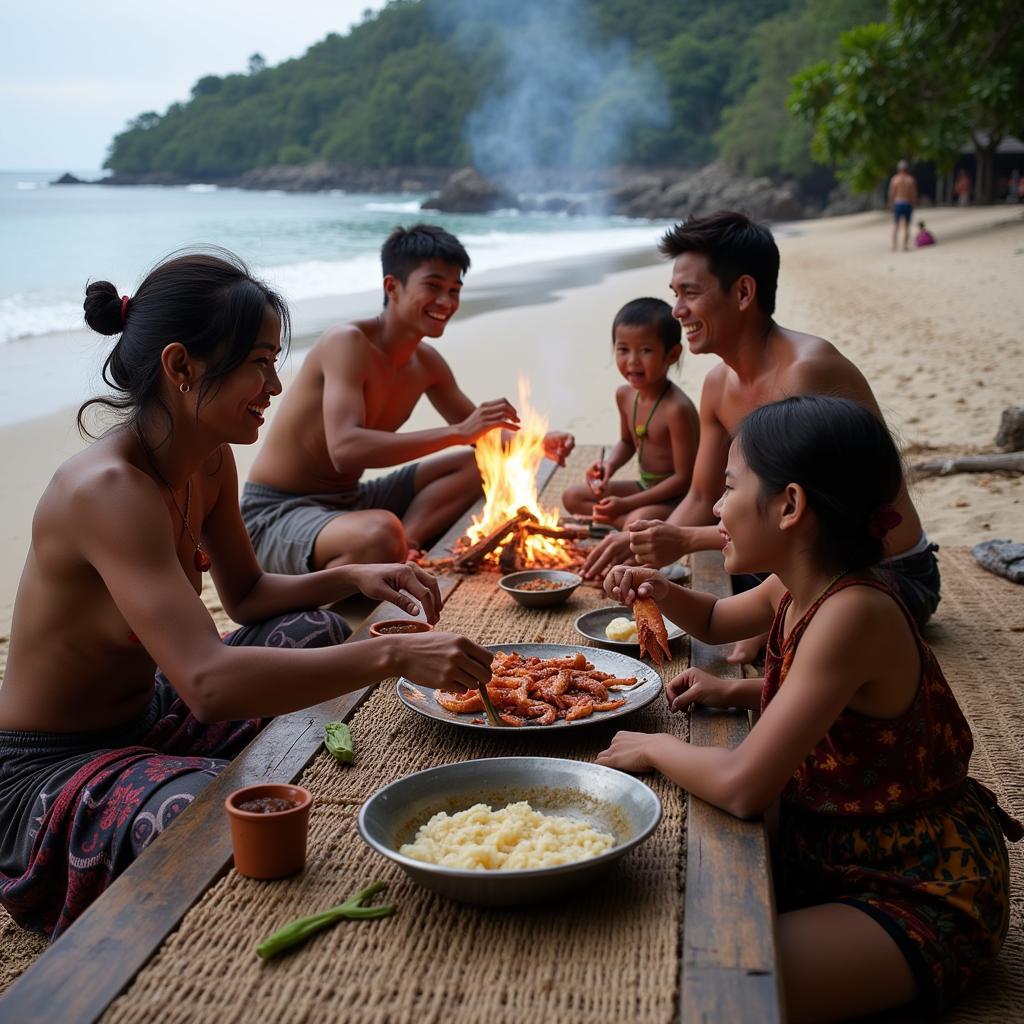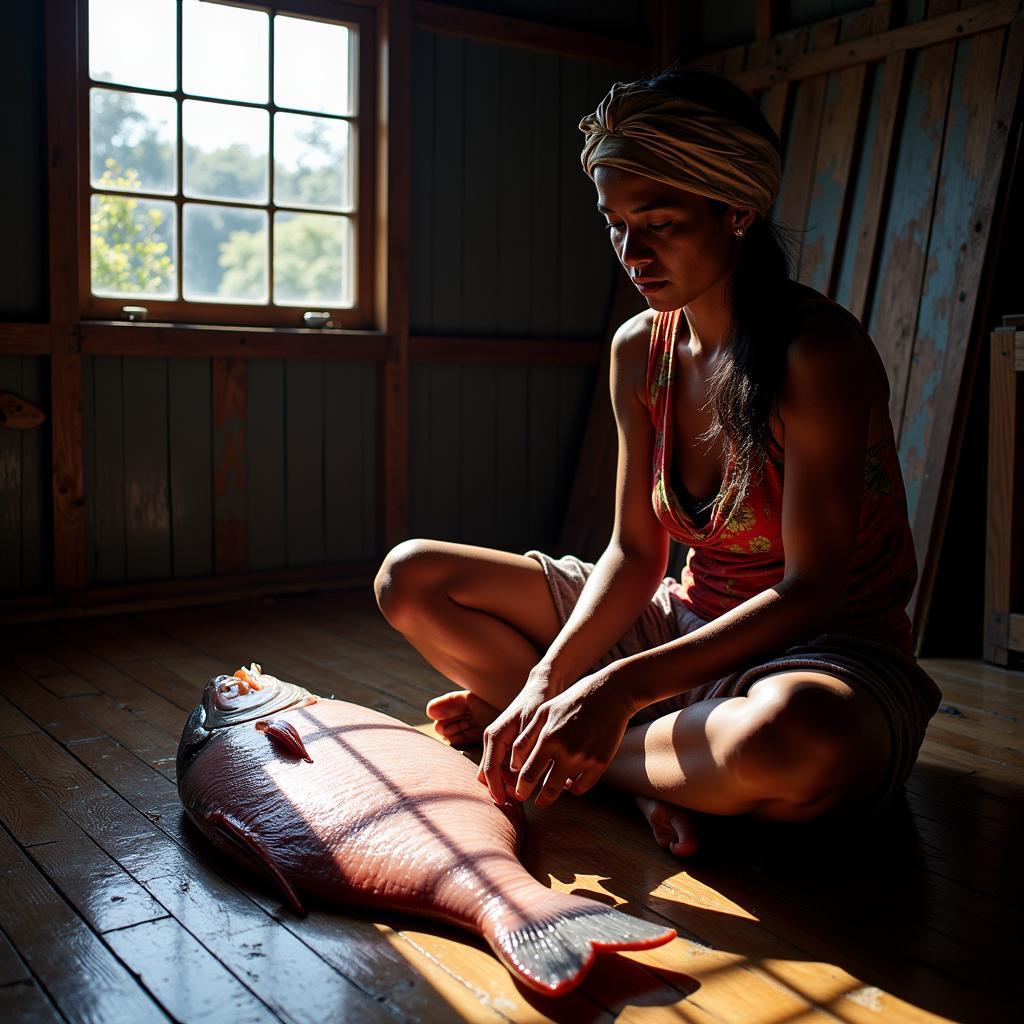The Bajau people, often referred to as the “Sea Nomads” of Southeast Asia, have a unique and vibrant culture deeply intertwined with their marine environment. Their traditional lifestyle, heavily reliant on the ocean’s bounty, has shaped not only their traditions and beliefs but also their cuisine. Bajau Food is a testament to their resourcefulness and adaptability, showcasing the ingenuity with which they transform readily available seafood and local ingredients into flavorful and nourishing dishes.
 A Bajau family preparing a seafood meal together.
A Bajau family preparing a seafood meal together.
The Ocean’s Gift: Staple Ingredients in Bajau Cuisine
For the Bajau people, the ocean is their garden, providing an abundance of ingredients that form the cornerstone of their diet. Fish, naturally, reigns supreme. From small reef fish to larger pelagic species, it is prepared in countless ways – grilled over open fires, simmered in fragrant broths, or sun-dried and salted for preservation. Shellfish, too, are highly prized, with clams, crabs, and lobsters frequently making their way into Bajau kitchens.
Beyond the obvious protein sources, the Bajau utilize a variety of marine resources in their cooking. Seaweed, for instance, is incorporated into soups, salads, and even desserts. Cassava, a starchy root, offers a versatile carbohydrate source and is often ground into flour or boiled as a side dish. Spices like ginger, turmeric, and lemongrass, readily available in their island home, add depth and complexity to their dishes.
 A Bajau woman expertly cleaning freshly caught fish.
A Bajau woman expertly cleaning freshly caught fish.
A Symphony of Flavors: Signature Bajau Dishes
While the specific dishes vary depending on location and available ingredients, some culinary creations are considered emblematic of Bajau food culture. One such dish is kinilaw, a raw seafood preparation similar to ceviche. Fresh fish or shellfish are marinated in a mixture of vinegar, onions, ginger, and chilies, resulting in a tangy and refreshing delicacy.
Another iconic dish is uyap, a flavorful porridge made from tapioca starch and coconut milk. Often served with sweet or savory toppings, uyap showcases the Bajau’s ability to create comforting and satisfying meals from simple ingredients.
“The beauty of Bajau cuisine lies in its ability to highlight the natural flavors of the ingredients,” says culinary anthropologist Dr. Maya Hassan, “There’s a deep respect for the ocean’s bounty, and the cooking methods often emphasize simplicity and freshness.”
Preserving Traditions in a Changing World
As the world modernizes, the traditional lifestyle of the Bajau people faces numerous challenges. Overfishing, environmental degradation, and assimilation into mainstream cultures have all impacted their foodways. Despite these challenges, many Bajau communities remain committed to preserving their culinary heritage.
Efforts are underway to document traditional recipes, promote sustainable fishing practices, and raise awareness about the importance of preserving Bajau food culture. These initiatives aim to ensure that future generations can continue to savor the unique flavors and traditions that make Bajau food so special.
Conclusion
Bajau food is a testament to the resilience and adaptability of the “Sea Nomads.” Their cuisine, deeply rooted in their marine environment, offers a fascinating glimpse into their culture and way of life. From fresh seafood to starchy staples and flavorful spices, every ingredient tells a story of resourcefulness and respect for the ocean. By learning about and appreciating Bajau food, we can contribute to the preservation of their unique culinary traditions for generations to come.
FAQs
1. What is the most common cooking method in Bajau cuisine?
Grilling over an open fire is the most common cooking method, followed by simmering in broths and sun-drying.
2. Are there any vegetarian options in Bajau food?
While seafood is central to Bajau cuisine, vegetarian options do exist, primarily utilizing ingredients like cassava, coconut milk, and various vegetables.
3. Where can I try authentic Bajau food?
The best way to experience authentic Bajau food is to visit regions with a significant Bajau population, such as parts of Malaysia, Indonesia, and the Philippines.
4. Are there any efforts to preserve Bajau food traditions?
Yes, organizations and individuals are working to document recipes, promote sustainable fishing, and raise awareness about the importance of preserving Bajau food culture.
5. How has modernization impacted Bajau cuisine?
Modernization has led to challenges like overfishing and the availability of processed foods, impacting the availability of traditional ingredients and cooking methods.
Need help exploring more culinary delights? Contact us at Phone Number: 02437655121, Email: minacones@gmail.com Or visit us at: 3PGH+8R9, ĐT70A, thôn Trung, Bắc Từ Liêm, Hà Nội, Việt Nam. Our customer service team is available 24/7. Discover more captivating food stories on our website, Mina Cones Food.